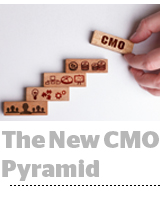 For decades, the global CMO role has been the pinnacle of the marketing career pyramid, because the largest brands, like Mars, Coca-Cola and Unilever, needed a single executive to oversee content and messaging across the portfolio.
For decades, the global CMO role has been the pinnacle of the marketing career pyramid, because the largest brands, like Mars, Coca-Cola and Unilever, needed a single executive to oversee content and messaging across the portfolio.
But the days of the global CMO may be nearing an end.
Coca-Cola scrapped its global CMO role late last year, shifting the responsibilities to Chief Growth Officer Francisco Crespo, and to marketers for specific brands or regions. Unilever CMO Keith Weed is stepping down this year, with no replacement in sight. And Johnson & Johnson’s first-ever global CMO Alison Lewis departed last month, as the company retires the position.
So what’s driving this sudden turnover in top CMO jobs?
End of the TV era
In a marketing world powered by television, a global CMO was needed to hone the brand’s messaging and manage relationships with a finite number of media channels. Producing fewer commercials and consolidating TV buys across many brands were the main ways to maximize efficiency.
But the era of the “centralized command and control CMO” is going away, said Larry Thomas, managing director of Accenture’s customer insights and growth practice.
Digital media companies and smartphones have fractured TV as the main pillar of global branding, swinging the marketing pendulum back to regional media and expertise, said David Jones, founder and CEO of the marketing agency and technology group You & Mr Jones.
Instead of delivering efficiencies by producing fewer commercials or by wringing better terms from broadcasters, Jones said marketers now must constantly create and distribute content, without top-down control. Many large brands have also in-housed marketing and technology operations, which means there are more fields and expertise within the overall marketing org than can be overseen by a single person, he said.
The newly empowered marketer?
Top CMO roles are disappearing, but counterintuitively that may be a good sign for the career prospects of ambitious brand marketers.
“Many established businesses were built in a place where manufacturing, finance, operations and marketing could all be neatly separated,” said Publicis Chief Growth Officer Rishad Tobbaccowala.
Brands like Uber or Dollar Shave Club, which was acquired by Unilever, put marketers behind the controls of the site and app, customer service and experience, delivery and physical supply chain management, he said. And incumbent brands are learning from those DTC models, with a more empowered role for marketing and analytics.
DTC brands and digital performance marketing strategies have connected marketing to sales and growth, which puts it on the radar for presidents, CEOs and CFOs, Jones said.
On the up and up
CMOs have historically had a “soft power,” where they could persuade top level executives to make investments or adopt different business practices, said Brian Weiser, GroupM’s global president of business intelligence.
But new C-level titles like “Chief Growth Officer,” “Chief Experience Officer” and “Chief Digital Officer” indicate future avenues for growth for marketers with stronger revenue and operational authority.
And don’t sleep on marketers rising to even higher jobs.
The liquor and beverage brand Beam Suntory got rid of its global CMO role after Rebecca Messina left to become Uber CMO. Last month, it replaced the title with a more powerful ‘President of Brands’ position, filled by Jessica Spence.
The new position owns P&L responsibility for the brands, compared to the CMO previously having to justify any additional spend, without control over the purse strings.
Last year, the candy and snack conglomerate Mars promoted then-CMO Andrew Clarke to president of the company’s confectionery group. It means he oversees fewer brands, but has executive responsibilities.
When Kraft-Heinz named a new CEO in April, it selected AB InBev CMO Miguel Patricio. And Unilever went with an internal hire to replace Paul Pollman, its longtime CEO who retired this year, by promoting former beauty and personal care brand marketer Alan Jope to the top job.
“More and more marketers are being assigned to growth or to oversee a transformation agenda,” Thomas said. “Sometimes it can be just a more hip CMO role, but often it’s a comprehensive change with responsibilities across the organization.”
This post was syndicated from Ad Exchanger.


More Stories
Waka Kotahi tackles drug driving with FCB and MBM
Unbound joins HubSpot for elite client data
Citigroup Scales Back DEI Initiatives